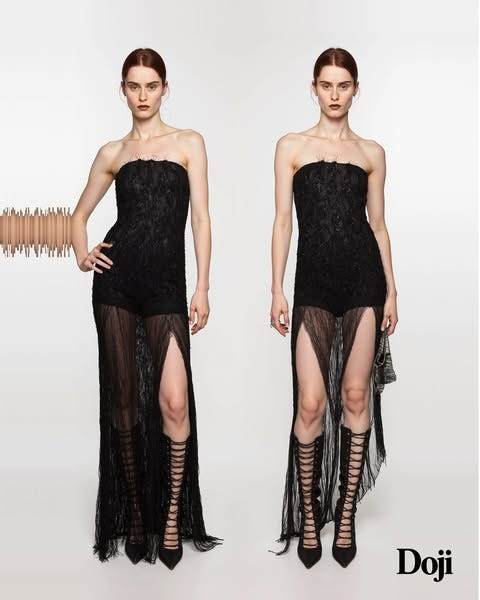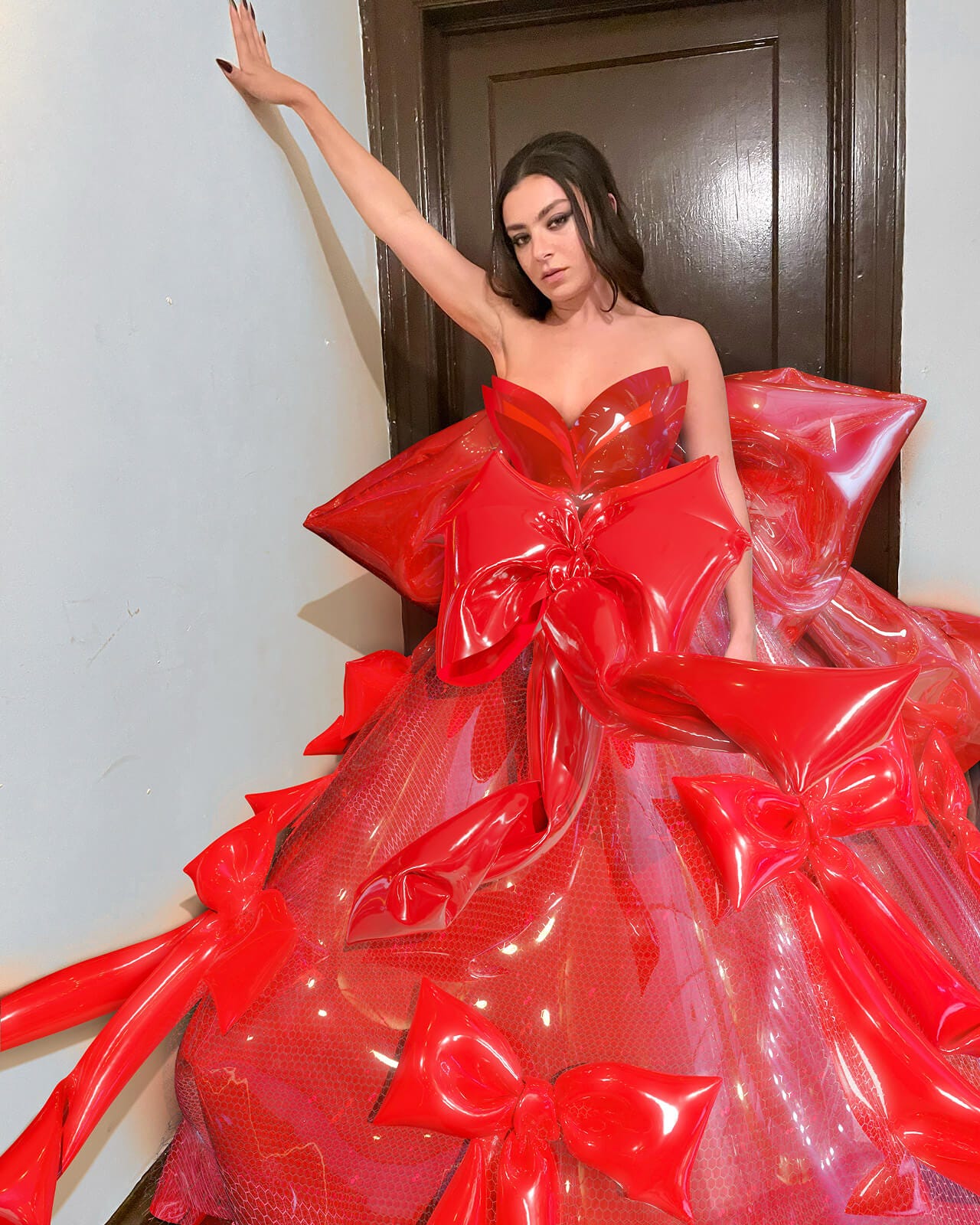clout in the age of infinite reproduction
what happens to fashion when anyone can appear to have anything?
This Outfit Does Not Exist is a newsletter exploring technology’s impact on fashion, status and culture. If this sounds even remotely interesting.
This piece was originally published on Dirt.fyi – the next-generation entertainment platform using emerging technology to tell the coolest stories about culture and collecting. If you like this
Envy tastes like stale milk. When I scroll through @sitabellan’s feed I taste it, and immediately understand why being stunned is colloquialized as gagging. Across Sita Abellán’s grid the multi-hyphenate techno-princess smizes through a pane of synthetic hair, dressed in clothes so outlandish that even her Uddenberg-coded contortions fail to eclipse them.
As an astrologically-fated attention seeker (I’m a Leo, duh) I’ve gleaned inspiration from Abellán for years. Yet her clothes still nudge my little green monster to skitter on screen by virtue of their inaccessibility. Haute couture, archive or custom, most of Abellán’s outfits cannot be bought—only gifted. But now a slew of virtual try-on technologies are upending fashion’s exclusivity in ways formerly unprecedented, by allowing anyone to wear anything online.
This disruption ramped up late last year when ‘fash-tech’ (aka. fashion technology) startup Doji came to market with a slew of gloat-posts from invited beta-testers. The app allows users to create an AI likeness to try on real luxury products and eventually shop within the app. While it’s raised $14 million by selling the dream of increasing e-comm conversion rates, and reducing returns, Doji’s real appeal lies in its promise of digitally democratized glow-ups.
Doji’s real appeal lies in its promise of digitally democratized glow-ups.
By simply copy-pasting the URL of a fashion product into the app's expectant search bar you can dress your Doji avatar (a hotter version of you) in any fashion piece found on the internet. No matter if its physical counterpart is on a rail in Zendaya’s bathroom or swathed in tissue paper in the archives of The Met.
When Marc Andreessen declared that software was eating the world back in 2011, few luxury execs expected to feel teeth in the back of their Prada blazers. Fashion is a notoriously hypocritical industry, embracing novelty-obsessed hacks while turning up its nose at true innovation. Fourteen years after Andreessen’s declaration, fashionistas love to wax lyrical about the importance of tangibility whilst intermediating the world through the latest iPhone camera. After all, once you cut through the propaganda that attributes fashion’s value to its craftsmanship, the viscid core of this $471 billion luxury industry is conveying clout.
Fashion is a notoriously hypocritical industry, embracing novelty-obsessed hacks while turning up its nose at true innovation.
Over the past decade, the resident anthropologists at LVMH and Kering have found that nothing powers the buy-share-repeat cycle like social media. “Social networks do best when they tap into one of the seven deadly sins,” said LinkedIn founder Reid Hoffman, also in 2011.
, who writes the newsletter Digital Native, says Instagram’s deadly sin is Envy.At first, Instagram was every luxury CMO’s wet dream. Who wouldn’t want to leverage the putrid stench of aspiration to transfer the onus of image making from fashion creators to fashion consumers? Every insta-girly could become a sales assistant sans commission. As Ana Kinsella writes in her piece on flat fashion, “When we dress to be photographed, we increasingly dress to be distributed as an image, and thus transformed into a kind of ad.”
Then came COVID. When a pandemic plunged the world into a shared state of digital dependence, this focus on the image took an inauspicious turn. As isolated consumers went all in on buying clothing “on the basis of how it looks in two dimensions,” to paraphrase Kinsella, a host of designers realized that materiality no longer mattered. They proffered a new form of fashion, one that only existed digitally, known as Instagram Couture.
Charli XCX hard-launched Carolina Herrera’s foray into Instagram Couture in 2022. Scared shitless of the revolution to come, CH’s creative director Wes Gordon enlisted Vogue to publish a gushing interview about his collaboration with Tribute Brand that transformed the season’s look 45 into a piece of virtual fashion.
Fortunately for Wes and co, the first crop of virtual clothes were not adequate challengers to their physical counterparts. For one thing, they were designed with digital tools, for digital natives, and so resembled balloons filled to burst, iridescent fins or upchucks of slime. For another, technological limitations hampered pieces with clear visual tells. An AR trouser leg disappearing mid-motion was akin to the misspellings on a shanzhai shirt bearing the slogan Dolce & Banana.
An AR trouser leg disappearing mid-motion was akin to the misspellings on a shanzhai shirt bearing the slogan Dolce & Banana.
Unfortunately for the 215,000+ LVMH employees who thought they were in the clear, Doji’s different. The pieces that elevate its AI avatars into an army of SSENSIFIED it-boys and girls are indiscernible from their physical counterparts. In his seminal essay The Work of Art in the Age of Mechanical Reproduction, Walter Benjamin challenges such a reality. He argues that the mechanical reproduction of artworks diminishes their aura—the unique presence they hold in a particular time and place.
Reproduced art is detached from tradition and ritual, shifting its value from cultic reverence to political utility. While mechanically created works lose the singular authenticity of the original, they are not entirely without value; instead, they represent a new mode of engagement with art in modern society, one that potentially democratizes access.
Benjamin questioned whether there can be such a thing as “art for art’s sake” without eventually serving regressive ends. By the time Kinsella concludes her exploration of flat fashion, “fashion for fashion’s sake” becomes an appropriate diagnosis. But when apps like Doji jam exclusivity’s cogs with the wrench of digital abundance, what can still be described as fashion? Where are the gluten-free breadcrumbs leading the hordes of fashion victims to the safe havens that status builds?
Right now I’m unsure. One possible answer: status accrues to curation, as in Daisy Alioto’s Taste Economy. The industry will laud those best at filtering through infinite digital closets to construct ‘a look’ in a franchise of Dress to Impress where the R15 doll is you. It would then be more appropriate to remark that taste is eating the world.
We could see a future where IRL fashion experiences once again subsume images.
Perhaps consumers will be pushed to become creators—upcycling with OpenAI (or even digitally thrifting) to ensure an original fit. We could see a future where IRL fashion experiences once again subsume images. A regression I envision beginning with Abellán blown up like a Macy’s balloon, her pixel flesh flushed with oxygen, her clothes distending to the crunch of a broken screen protector.
If something similar to Robin Dunbar’s theory that humans can only have 150 meaningful relationships is applied to fashion, the opportunity cost of sharing our style—that Instagram has set to zero—will once again become a signal. And those we curate to ‘witness’ us will become as significant as the looks we pull.
– Dani




